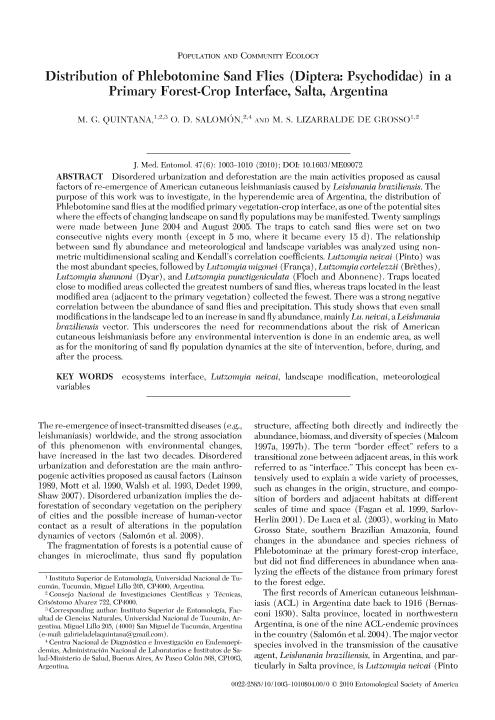Mostrar el registro sencillo del ítem
dc.contributor.author
Quintana, María Gabriela

dc.contributor.author
Salomón, Oscar Daniel

dc.contributor.author
Lizarralde, Mercedes Sara

dc.date.available
2022-11-30T20:14:10Z
dc.date.issued
2010-11
dc.identifier.citation
Quintana, María Gabriela; Salomón, Oscar Daniel; Lizarralde, Mercedes Sara; Distribution of Phlebotomine sand flies (Diptera: Psychodidae) in a primary forest-crop interface, Salta, Argentina; Entomological Society of America; Journal of Medical Entomology; 47; 6; 11-2010; 1003-1010
dc.identifier.issn
0022-2585
dc.identifier.uri
http://hdl.handle.net/11336/179646
dc.description.abstract
Disordered urbanization and deforestation are the main activities proposed as causal factors of re-emergence of American cutaneous leishmaniasis caused by Leishmania braziliensis. The purpose of this work was to investigate, in the hyperendemic area of Argentina, the distribution of Phlebotomine sand flies at the modified primary vegetation-crop interface, as one of the potential sites where the effects of changing landscape on sand fly populations may be manifested. Twenty samplings were made between June 2004 and August 2005. The traps to catch sand flies were set on two consecutive nights every month (except in 5 mo, where it became every 15 d). The relationship between sand fly abundance and meteorological and landscape variables was analyzed using non-metric multidimensional scaling and Kendall's correlation coefficients. Lutzomyia neivai (Pinto) was the most abundant species, followed by Lutzomyia migonei (Frana), Lutzomyia cortelezzii (Brthes), Lutzomyia shannoni (Dyar), and Lutzomyia punctigeniculata (Floch and Abonnenc). Traps located close to modified areas collected the greatest numbers of sand flies, whereas traps located in the least modified area (adjacent to the primary vegetation) collected the fewest. There was a strong negative correlation between the abundance of sand flies and precipitation. This study shows that even small modifications in the landscape led to an increase in sand fly abundance, mainly Lu. neivai, a Leishmania braziliensis vector. This underscores the need for recommendations about the risk of American cutaneous leishmaniasis before any environmental intervention is done in an endemic area, as well as for the monitoring of sand fly population dynamics at the site of intervention, before, during, and after the process. © 2010 Entomological Society of America.
dc.format
application/pdf
dc.language.iso
eng
dc.publisher
Entomological Society of America

dc.rights
info:eu-repo/semantics/openAccess
dc.rights.uri
https://creativecommons.org/licenses/by-nc-sa/2.5/ar/
dc.subject
ECOSYSTEMS INTERFACE
dc.subject
LANDSCAPE MODIFICATION
dc.subject
LUTZOMYIA NEIVAI
dc.subject
METEOROLOGICAL VARIABLES
dc.subject.classification
Zoología, Ornitología, Entomología, Etología

dc.subject.classification
Ciencias Biológicas

dc.subject.classification
CIENCIAS NATURALES Y EXACTAS

dc.title
Distribution of Phlebotomine sand flies (Diptera: Psychodidae) in a primary forest-crop interface, Salta, Argentina
dc.type
info:eu-repo/semantics/article
dc.type
info:ar-repo/semantics/artículo
dc.type
info:eu-repo/semantics/publishedVersion
dc.date.updated
2021-09-01T13:50:16Z
dc.journal.volume
47
dc.journal.number
6
dc.journal.pagination
1003-1010
dc.journal.pais
Estados Unidos

dc.journal.ciudad
Lanham
dc.description.fil
Fil: Quintana, María Gabriela. Universidad Nacional de Tucumán. Facultad de Ciencias Naturales e Instituto Miguel Lillo. Instituto Superior de Entomología; Argentina. Consejo Nacional de Investigaciones Científicas y Técnicas. Centro Científico Tecnológico Conicet - Tucumán; Argentina
dc.description.fil
Fil: Salomón, Oscar Daniel. Dirección Nacional de Institutos de Investigación. Administración Nacional de Laboratorios e Institutos de Salud. Centro Nacional de Diagnóstico e Investigaciones Endemo-epidémicas; Argentina. Consejo Nacional de Investigaciones Científicas y Técnicas. Centro Científico Tecnológico Conicet - Tucumán; Argentina
dc.description.fil
Fil: Lizarralde, Mercedes Sara. Universidad Nacional de Tucumán. Facultad de Ciencias Naturales e Instituto Miguel Lillo. Instituto Superior de Entomología; Argentina. Consejo Nacional de Investigaciones Científicas y Técnicas. Centro Científico Tecnológico Conicet - Tucumán; Argentina
dc.journal.title
Journal of Medical Entomology

dc.relation.alternativeid
info:eu-repo/semantics/altIdentifier/doi/https://doi.org/10.1603/me09072
dc.relation.alternativeid
info:eu-repo/semantics/altIdentifier/url/https://academic.oup.com/jme/article/47/6/1003/993226?login=false
Archivos asociados
